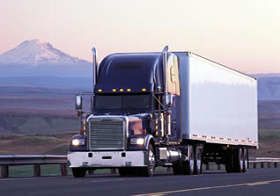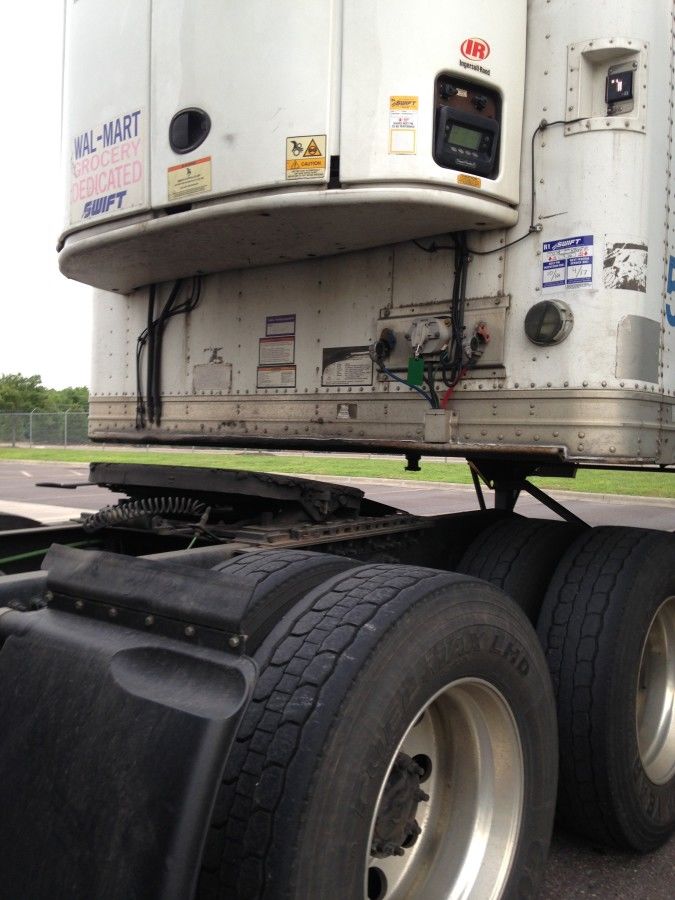Please Don't Do This To Your Fellow Drivers.
Topic 21676 | Page 2
I normally lower the gear till about an inch or so from the ground. Drop the bags and pull. My company has all the same truck models and we all do roughly the same. Makes drop and hooks a breeze.
I will admit I miss judged a trailer spot coming under it from a small depression. The initial spot looked good, till I went under and heard the kingpin slide right over the 5th wheel  . I had to play the wiggle game an inch at a time, to slowly get the 5th wheel out and around the kingpin without damaging any equipment. Tell you what, I won't make that mistake again!
. I had to play the wiggle game an inch at a time, to slowly get the 5th wheel out and around the kingpin without damaging any equipment. Tell you what, I won't make that mistake again!
No shame in admitting and learning from mistakes
Dm:
Dispatcher, Fleet Manager, Driver Manager
The primary person a driver communicates with at his/her company. A dispatcher can play many roles, depending on the company's structure. Dispatchers may assign freight, file requests for home time, relay messages between the driver and management, inform customer service of any delays, change appointment times, and report information to the load planners.Drop And Hook:
Drop and hook means the driver will drop one trailer and hook to another one.
In order to speed up the pickup and delivery process a driver may be instructed to drop their empty trailer and hook to one that is already loaded, or drop their loaded trailer and hook to one that is already empty. That way the driver will not have to wait for a trailer to be loaded or unloaded.

Thanks G-town will do that next time, also I keep seeing lowering the airbags. How does one do that, I drive a 16 freightshaker cascadia evo
Thanks G-town will do that next time, also I keep seeing lowering the airbags. How does one do that, I drive a 16 freightshaker cascadia evo
Should be a switch that has a truck without a trailer with a Up and down arrow at the rear.

My quick answer to dumping the air from the suspension when dropping a trailer; I don't do it.
I learned the first few months into my rookie experience and was re-taught that it's unnecessary. I'll explain my answer in a bit...when I have time offer something more complete.

Don't see it mine must not have it. Thanks though!
Thanks G-town will do that next time, also I keep seeing lowering the airbags. How does one do that, I drive a 16 freightshaker cascadia evo
Should be a switch that has a truck without a trailer with a Up and down arrow at the rear.

So yeah, I do not dump the air from the suspension when droppIng a trailer. Haven't for many years now.
It's not really necessary 99% of the time. This is especially true on a slippery surface of ice and snow. Dumping the air will reduce the downward force on the tractor drives and minimize the traction necessary to get out from under a trailer on a snow packed surface. Locking the differential and overriding traction control also improves your chances of not getting stuck in a snowpack when dropping an empty trailer.
Dumping the air also tends to leave the fifth wheel in a less-than optimal position to get under your next trailer; too "flat", with the primary surface almost level. The two wings of the fifth wheel should be resting on the snubbers enabling it to more easily "wedge" under the next trailer. This is part of what it's designed to do.
The only time I would dump the air when dropping is if on a rather soft surface. It will cushion the landing so-to-speak. Most of the time I am dropping on a concrete pad, asphalt or packed gravel so at least for me, dumping the air is an unnecssary step.
One other thing to keep in mind. I vary how much I lower the landing gear; empty about an inch from the ground, loaded make contact with the ground plus an additional turn.
The only times I will dump the air from the suspension is to get under a trailer that's set a bit too low, or to slightly raise the rear of the trailer deck to better align with an older/high dock and as part of the process to move the fifth wheel.
So yeah, I do not dump the air from the suspension when droppIng a trailer. Haven't for many years now.
It's not really necessary 99% of the time. This is especially true on a slippery surface of ice and snow. Dumping the air will reduce the downward force on the tractor drives and minimize the traction necessary to get out from under a trailer on a snow packed surface. Locking the differential and overriding traction control also improves your chances of not getting stuck in a snowpack when dropping an empty trailer.
Dumping the air also tends to leave the fifth wheel in a less-than optimal position to get under your next trailer; too "flat", with the primary surface almost level. The two wings of the fifth wheel should be resting on the snubbers enabling it to more easily "wedge" under the next trailer. This is part of what it's designed to do.
The only time I would dump the air when dropping is if on a rather soft surface. It will cushion the landing so-to-speak. Most of the time I am dropping on a concrete pad, asphalt or packed gravel so at least for me, dumping the air is an unnecssary step.
One other thing to keep in mind. I vary how much I lower the landing gear; empty about an inch from the ground, loaded make contact with the ground plus an additional turn.
The only times I will dump the air from the suspension is to get under a trailer that's set a bit too low, or to slightly raise the rear of the trailer deck to better align with an older/high dock and as part of the process to move the fifth wheel.
Question about the 5th wheel being to flat. Is that a older type or a fair new one? The 2016 Volvo I drive the 5th wheel gets into that proper position you mentioned as soon as I pop out from under the trailer. Making the next hook easy. This is using the air dump method.
Also, what type of drive tires are you running? We've got some pretty meaty hexagon (ish) cut drive tires. They've gripped pretty good even after a 6+ inch snowstorm.
Honestly curious about what others are rolling. Appreciate your detailed explanation on how you do it.

No, newer 2016 Cascadia.
The "too flat" reference was meant to describe what can happen if cranking the trailer too high and dumping the air. Downforce of the trailer comes "off" too soon leaving the fifth wheel almost level.
I hear you,..."beefy tires" or not, when you dump your air the weight of the trailer is no longer exerting downward force on the drives, compromising traction in snow or ice when getting out from under a trailer.
Below is one of the "better" examples of a trailer cranked too high that I dealt with last summer. I believe the reason I took it was because the gear was almost fully extended.

Notice the angle of the fifth wheel. Optimal position to wedge under a trailer.
Got ya.
I guess I'm terrible at explaining. Next time I drop and hook I'll try and take some pictures to better illustrate what I was referencing to. Likely won't be till next week though, I've been pushing pretty tight schedules this week though I expect after my next delivery I'll be heading upto one of our regular drop sites with a load.
Drop And Hook:
Drop and hook means the driver will drop one trailer and hook to another one.
In order to speed up the pickup and delivery process a driver may be instructed to drop their empty trailer and hook to one that is already loaded, or drop their loaded trailer and hook to one that is already empty. That way the driver will not have to wait for a trailer to be loaded or unloaded.
New Reply:
New! Check out our help videos for a better understanding of our forum features

















Preview:
This topic has the following tags:
Advice For New Truck Drivers Tips for Parking Trailers Truck Equipment







 TT On Facebook
TT On Facebook
A lot of times the ground itself will dictate the height the trailer is at, as JJ pointed out. Often times the ground isn't level in gravel lots and you have a lot of potholes. If a yard dog moves the trailer to the doors and then parks it once again in the lot he probably isn't going to park it in the exact same location it was in before. Now the landing gear might be in a hole or there are deep grooves where the tractor sits or some other variable.
The ride height from truck to truck varies also. Some drivers drop their airbags before dropping the trailer, others might be in older trucks which sit higher on less expensive high profile tires and don't have airbags.
No one is dropping trailers in such a way that they're purposely trying to make it tough on the next driver who is going to pick it up. There are a lot of variables that go into it.